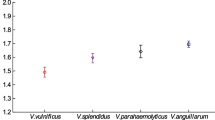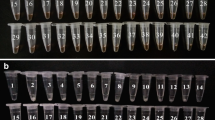Abstract
Vibrio vulnificus is an opportunistic pathogen widely distributed in estuarine and coastal seawaters. In this study, a culture-free method was developed to rapid detection of V. vulnificus in all seasons, based on loop-mediated isothermal amplification (LAMP) targeting virulent-correlated gene (vcg). The new assay method allows differentiation between the virulent and non-virulent strain of V. vulnificus accurately. This method also allows effective detection of the pathogeny in winter when the bacterium lives in the viable but non-culturable (VBNC) state. A total of 30 costal seawater samples collected in all seasons were used for the evaluation of this method. The results show that the method is sensitive, accurate and convenient.
Similar content being viewed by others
References
Dechet A M, Yu P A, Koram N, et al. 2008. Nonfoodborne Vibrio infections: an important cause of morbidity and mortality in the United States, 1997–2006. J Clin Infect Dis, 46: 970–976
Han Feifei, Ge Beilei. 2008. Evaluation of a Loop-Mediated Isothermal Amplification Assay for Detecting Vibrio vulnificus in Raw Oysters. Foodborne Pathogens and Disease, 5: 311–320
Gulig P A, Bourdage K L, Starks A M. 2005. Molecular Pathogenesis of Vibrio vulnificus. J Microbiol, 43: 118–131
Kamio A, Hara-Kudo Y, Miyasaka J, et al. 2008. Efficiency of real-time polymerase chain reaction assay to detect Vibrio vulnificus in seawater. Int J Hyg Environ Health, 211: 518–523
Notomi T, Okayama H, Masubuchi H, et al. 2000. Loopmediated isothermal amplification of DNA. Nucleic Acids Res, 28: e63
Oliver J D. 1995. The viable but non-culturable state in the human pathogen Vibrio vulnificus. FEMS Microbiology Letters, 133: 203–208
Rivera I N, Lipp E K, Gil A, et al. 2003. Method of DNA extraction and application of multiplex polymerase chain reaction to detect toxigenic Vibrio cholerae O1 and O139 from aquatic ecosystems. Environ Microbiol, 5: 599–606
Rosche T M, Yano Y, Oliver J D. 2005. A rapid and simple PCR analysis indicates there are two subgroups of Vibrio vulnificus which correlate with clinical or environmental isolation. Microbiol Immunol, 49: 381–389
Strom M S, Paranjpye R N. 2000. Epidemiology and pathogenesis of Vibrio vulnificus. Microbes and Infection, 2: 177–188
Wegley L, Mosier-Boss P, Lieberman S, et al. 2006. Rapid estimation of microbial numbers in water using bulk fluorescence. Environmental Microbiology, 8: 1775–1782
Zengler K, Toledo G, Rappe M, et al. 2002. Cultivating the uncultured. Proc Natl Acad Sci USA, 99: 15681–15686
Author information
Authors and Affiliations
Corresponding author
Additional information
Foundation item: The National High-Tech Research and Development Program of China (“863”) under contract No.2006AA09Z170.
Rights and permissions
About this article
Cite this article
Li, Y., Zheng, Z., Zhao, Y. et al. A culture-free method for detection of Vibrio vulnificus from coastal seawater based on loop-mediated isothermal amplification targeting vcgC gene. Acta Oceanol. Sin. 29, 93–97 (2010). https://doi.org/10.1007/s13131-010-0027-x
Received:
Accepted:
Published:
Issue Date:
DOI: https://doi.org/10.1007/s13131-010-0027-x




